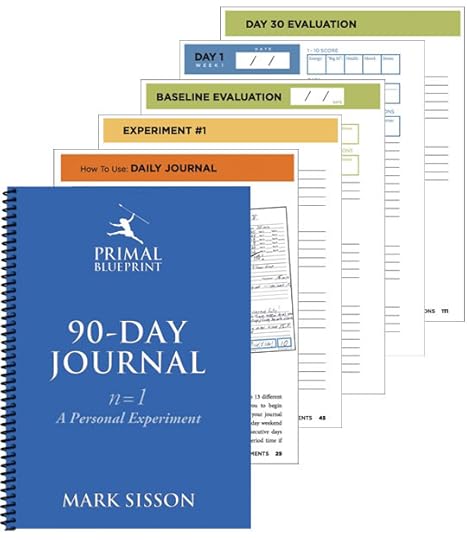Mark Sisson's Blog, page 378
July 6, 2012
Where Are They Now?
 Remember Tara? Derek? Paul? Albert? These are just a few of the Mark’s Daily Apple readers that sent in their success stories a year or more ago. Their stories were an inspiration to us all. Testament to this fact are the emails I receive from fellow-PBers asking how they are doing. Today we find out.
Remember Tara? Derek? Paul? Albert? These are just a few of the Mark’s Daily Apple readers that sent in their success stories a year or more ago. Their stories were an inspiration to us all. Testament to this fact are the emails I receive from fellow-PBers asking how they are doing. Today we find out.
You may recall that when Tara sent in her story at the end of 2010 she had been Primal for a year and a half, and had finally found solutions to a litany of health issues that doctors couldn’t. Derek had ditched grains and in the process lost weight, acid reflux and exercise induced asthma. Paul had gone from 300 to 150 pounds and gained self-confidence. And Derek had gone from 270 to 175, and was studying to be a personal trainer. Are they still Primal, happy and healthy? Read on for updates from each of them.
Tara
I hit my lowest weight of 135 lbs late last year and have since been in a maintenance phase, experimenting with what my body performs best on and what I can cheat with. I found that being 135 was actually too low for me – a problem I can honestly say I have never had before in my life – so I started eating breakfast occasionally, eating rice in small quantities, increasing my dairy and allowing myself chocolate more often than before. Basically, I undid all the “tweaks” I had done to lose that last 10 pounds. I’m back up to 145 lbs now and feel great. I had been considering plastic surgery to deal with some of the loose skin on my body, but gaining a little weight back has taken care of that issue naturally.
I’ve also been dealing with fructose malabsorption. This issue has been a tricky little devil. Things like carrots, apples and artichokes are now off the table, as are coconut flour and coconut milk. I’m not sure if I’ll have to abstain from these foods for the rest of my life or just until my gut heals, but the more I research the issue, the more I see that it is pretty common for a condition that no one has ever heard of. I’ll be doing a post about it once I have some definitive answers for myself.
I have decided that I don’t want to be a personal trainer and have signed up for the CHEK Holistic Life Coach course instead. A holistic, natural approach is much more appealing to me than the unrelenting world of fitness, body building and chronic cardio. I am also writing a Primal-related book. I’m very excited about this book but I’m not ready to reveal what it’s about yet. I’ll save that for the next update. 
I still blog at www.primalgirl.com. I recently had a couple posts about a nasty autoimmune condition called Hidradenitis Suppurativa that I managed to put into complete remission. The response to those posts has been overwhelming. I’ve been receiving comments from all over the world – not only are people grateful to finally put a name to what they’ve been suffering from, apparently my website is the only place on the Internet that provides constructive instructions on how to deal with this skin issue naturally. Most doctors don’t know how to diagnosis it, let alone treat it.
My twin boys are 3 ½ now and the time I spend cooking and feeding them leaves me a little anxious about how much more time this is going to take when they are 16-years old – and how much the grocery bill is going to be. They are eating more than my husband and I combined and are growing like weeds. Right now they’re the perfect weight for kettle bell swings (37 lbs). It’s a lot of fun for them, but they don’t realize that Mommy can’t quite do 56 sets of 90 KBS every hour, on demand. I’m working on it. My shoulders are very developed. 
I continue to biohack myself and remain committed to the Primal lifestyle. I recently started up a Primal Meetup group to get together with some of the wonderful people I met at PrimalCon and to meet others also following this lifestyle. It’s been wonderful connecting with people in real life. I still remember how I used to look, feel and perform before I went Primal and I can honestly say, I’m never going back.

I recently took a road trip out to New Mexico. Had to stand on a corner in Winslow, Arizona.
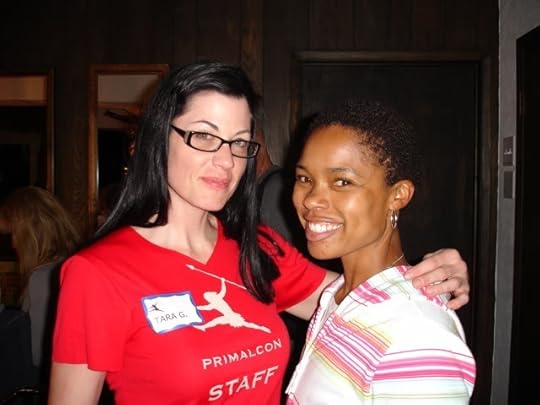
With Orleatha Smith at PrimalCon 2012.
Tara
Read Tara’s original Success Story here.
Derek
Hi Mark,
I think I sent you my initial story about two years ago? Anyway, if I recall, my wife had just become pregnant then. The pregnancy went great, no issues. She gave birth to our son almost one year ago (June). The birth went well and our child was born healthy, with the standard struggles of a new mom learning to breastfeed. One year later my wife is at her pre-pregnancy weight and fitness, with no struggles to lose the weight gained during pregnancy at all. I have maintained my weight and put on a bit of muscle just from doing less cardio (too busy to ski all day long), and spending more time lifting when Alex naps. I still don’t have any of the exercise induced asthma that I used to suffer from, which was my biggest health improvement from ditching the standard American diet.
We spent last winter skiing all the time with Alex. I think I skied about 50-60 days with the little bugger on my back, both nordic and backcountry, so that was great exercise! Now that spring is here, he’s in the bike trailer and we drag him around every evening. Thus far he’s pretty much spent every day, outside, in the mountains. He loves it, you can see it calm him down if he’s been cranky.

Since I contacted you two years ago, we’ve continued to eat “Primal”, making an effort to eat a wide range of high-quality, whole foods. We are not carb phobic in the slightest, in part because we are both active. Over the past few months, I have also started soaking/sprouting/fermenting buckwheat groats to make incredible “fast food” such as crepes, waffles, burritos, and pizza crust. We still don’t eat any sort of cereal grain, and neither my wife nor I have any desire to. Interesting though, the pressure people put on you when you tell them you’re not feeding your child little bits of highly processed baby snacks and all the other garbage made for babies. The pressure got heavy enough that my wife started to cave in a bit, then we discussed the meritless advice, and went back to feeding our youngster real food.

Anyway, our story wasn’t that dramatic, but I really think changing our diet is what helped my wife to finally get pregnant. We are both convinced of it. On that note, I am back in school working on a graduate nutrition/public health program. I’m hoping to transition out of ER nursing and work in obesity counseling in some capacity. Hopefully one day I can lead more people to this “way of life”, which I don’t necessarily call Primal. I like to think of it as living like your great Grandma did. Eat real food from good sources, move more, stress less, cut back on all the extra “stuff” in your life, simplify, sleep, hang with family.
I think your website, and some of the other big bloggers, are doing great things. You are raising awareness on nutrition and health, but also equally important, on lifestyle changes to improve health. Too many messages out there don’t include the entire package, your message does, and that is what makes it so valuable. I’m sure the message will continue to evolve as we gain more insight, but I hope the message keeps getting out to more people, because it’s a profound discovery once people find it.
Best regards,
Derek
Read Derek’s original Success Story here.
Paul
Hello Mark,
The last time we spoke I was going through very comprehensive knee surgery and working on getting my fitness back after a six month rehab. Shortly after that, near the end of 2011, myself, my brother, and our friend started a software company for our app Out of Milk and we ended up moving to San Francisco to get the company going strong. This has led to certain challenges, as trying to eat a clean diet in a city that loves it’s carbs and sweets makes it difficult when your life revolves around working lunches and meeting people for drinks and food! Luckily, there is an amazing Primal San Francisco Facebook group that helped me find the places I need to get my diet back on track. I’ve discovered the grass-fed meat scene is actually quite large here, and I’m enjoying a great selection of tasty animals!

The main problem for me has been that after my knee surgery it was difficult for me to continue maintaining a high level of fitness and I needed to figure out how to stay fit and healthy while doing the following:
1. Running a business
2. Not destroying my knees any further
3. Keeping the diet clean while doing #1 and #2
I’ve been a CrossFit fanboy on the MDA forums for a very long time, and after weeks of fighting it… I gave up the sport. I found that for me, personally, I was pushing my body too hard too often and not giving myself enough time to rest and recover to perform at both the gym and at work. I’ve since started training using a combination of kettlebells, pullup bars, rings, and a rowing machine. I love Brazilian Jiu Jitsu and by slowing my training down to a method less intensive on the body I’ve found that not only is my strength increasing but my ability to go into BJJ and not be sore, tired and achey is vastly improved.
When we first moved to SF I actually put on about 10 pounds while exploring all of the amazing restaurants, and once I realized what I was slipping into I immediately started focusing on meals from the Primal Blueprint Cookbook(s) and in less than a month was back on track to my normal weight. I thought giving up CrossFit would immediately turn me into a fat slob, but I guess all the articles you’ve written about not having to kill yourself while exercising really were true!
To sum things up: Lots of life changes, a completely new workout regimen, and still working on getting my knees back under me… but I’m getting work done, rockin’ the bjj, and eating lots of meat and that make’s life pretty great.
Oh yeah, and in case you want some pictures!
The first picture is a random shot from our first day in SF! The second picture is myself, my dad (used to be a professional gymnast and is nearing 60), and my brother who is now down almost 100 lbs total.

Thanks!
Paul
Read Paul’s original Success Story here.
Albert
Hi Mark!
It’s been a while yes! Hope you are doing well.
After writing you back in February last year I focused on learning as much as I could about nutrition, biology and sports science, let’s say it just got me hooked!
I am now working as a Personal Trainer and Nutritionist in Spain and still eating Primal of course! Having experimented a bit with carb intake I can safely say that while your carb intake curve is more than accurate for most folks, advanced trainees may need a bit more to perform well. What has worked for me was limiting nuts (those omega 6′s can really get you inflamed) and getting my carbs from potatoes, fruits and yams (sometimes a little quinoa goes well with meat).
I’ll leave you a pic I had taken while enjoying some time outdoors in this lovely weather!

As always, many thanks for encouraging people to improve themselves and to strive for better health and a better life altogether!
Albert
Read Albert’s original Success Story here.
Grab a Copy of The Primal Blueprint 90-Day Journal and Begin Your “Experiment of One”

July 5, 2012
Primal Road Trip: Tips and Tricks for Staying Healthy While Traveling
[image error] This is a guest post from Steve Kamb of NerdFitness.com
“ROAD TRIP!”
Are there two greater words in the English language?
Well, yeah probably. I mean, “free money,” “Royal Rumble,” and “grassfed steak,” just off the top of my head. But work with me here!
Anyways, everybody loves a good road trip – piling your friends into a car, picking a far-off destination, rolling down the windows, and singing Katy Perry at the top of your lungs (no on the Katy Perry? Okay cool, yeah me neither).
Whatever reason you have for putting rubber to the road, it’s important to not fall into the dreaded road trip trap that would make Grok weep: a backseat full of empty Red Bull cans and Funyun bags, enough candy wrappers to make Willy Wonka legitimately concerned, and the flexibility of a steel girder.
Let’s learn how to turn your road trip into a Primal adventure that would make Fred Flinstone proud.
Plan Ahead
Before going on a long road trip, you probably have a list of things to do:
Clean out the car
Get gas
Plan the route
Pick places to stop and places to stay
Load up the road trip playlist on your iPod
Make sure somebody feeds Spike, your pet cat/dog/tarantula
But everybody forgets the “plan out my Primal meals” part!
Which is why you end up stopping at Taco Bell at 10:00 pm as it’s the only place open, which results in you spending the next day in cruise control, curled up in a ball, feeling like there’s a brick in your stomach, driving 800 miles across Texas.
(Yes, that happened to me on my cross-country trip six years ago. Good times!)
Anywho, if you’re going to road trip, it means understanding ahead of time how long your trip is and what your current fitness goals are (weight loss? mass gain? maintenance?). Once you’ve got these things planned out, you can prepare ahead of time.
Here’s a sample list of Primal foods you can bring with you, with more Primal snacks here:
Fruit – A bag of apples? Pears? Bananas? Whatever floats your boat!
Beef Jerky – Not that processed junk you find at a gas station, but legitimate jerky! If you’re resourceful, you can even make your own.
Protein powder – Pick up some Primal Fuel or protein powder, get a mixing container and you will always have a meal. One scoop, fill up with water, shake, and chug.
Almonds – I never travel without a bag of almonds these days, as they’re delicious, nutritious, and filling. They are higher in calories than normal snacks and high in omega-6s, so aim for small servings. Almond butter is a great option too – a small amount spread across some apple slices might be the best snack ever invented.
Baby carrots and other veggies – Vegetables are fantastic because they’re loaded with nutrients and incredibly low on calories. They fill you up the right way.
Water – Apparently this stuff is pretty important.
If you have a mini cooler, you can toss it behind your seat or in the passenger seat and use that to keep your food cold and fresh.
Know Your Restaurants
At this point I’ll assume that you won’t just be eating snacks for the entirety of your trip… You’ll also be swinging through establishments of consumption called “restaurants.”
Here’s the first rule of healthy road-tripping: If you’re getting food from a drive-through window, it’s probably not good for you. Instead, identify a few choice restaurants that you already know have healthy options, and plan your stops around those.
The best method I’ve found for healthy road tripping is using an app called iExit (for iPhone or Android), which shows you how far away you are from your favorite restaurants. Once you know which restaurants offer your favorite Primal meal (like Chipotle or In-N-Out), you simply check a box and they tell you when they show up. It’s also a great app for finding gas stations, clean bathrooms, places to stay, and more. Well worth the $2.99 (though it’s currently on sale for 99 cents).
No smartphone? Do the best you can with what you’ve got. Aim for restaurants that allow you to maintain your style of eating.
Super late night driver? Try a Walmart! It’s usually safe, open 24-hours, and often has a food section that allows you to grab a rotisserie chicken and salad. On top of that, Walmarts are generally very close to the highway and a much safer stop if you’re road tripping solo than a gas station or truck stop.
Have time to swing a bit farther off the highway? Look into a Whole Foods, Trader Joe’s, or other grocery stores. If it’s open, try out the hot food section, grab one of their Primal-approved meals, and enjoy!
What if your ONLY option is a crappy restaurant? Do the best you can. Generally the grilled chicken options tend to be the least awful and processed. On top of that, most fast food places are starting to offer salads, fruit, and other healthy options. The toughest part will be smelling all of the amazingly disgusting unhealthy foods inside the restaurant. Instead, go through the drive-through, pick the healthy options, and move on!
Utilize Your Stops Effectively
There’s nothing worse than that stiff feeling in your legs, hips, and lower back after ten hours of driving. You walk around like a Lego character with no mobility for the rest of the day…not cool. Let’s try to avoid that.
I understand the importance of wanting to get wherever you’re headed as quickly and efficiently as possible. I know that sense of accomplishment you get from completing a trip in seven and a half hours when Google told you it would take eight. Swallow your pride, my dear friend, and spend a few minutes here and there taking care of yourself – your body will thank you.
Just because you’re on a road trip doesn’t mean you get to neglect your personal well-being by skipping out on your workouts. Remember that ANYTHING is better than nothing.
Fortunately, you’re versatile (right?), which means you can work out anytime, anywhere.
Road Warrior Workouts
Get your workouts done in the morning before you begin your drive. Yeah, you can do it at night once you get to your destination, but I find that an early morning workout outdoors or in your hotel room is much easier to complete than one after fourteen hours of driving.
Try one of these workouts:
The prison workout
The hotel room workout
The playground workout
Endorphine mainline Primal workout
Primal bodyweight exercises
In addition to that, you can also get back to nature by building a hike into your schedule. If you’re on a road trip through a particularly pretty part of the country, why not time your rest stop to coincide with a great hike? Here’s a huge searchable database of trails around the country.
Pressed for time? Try these five minute workout/stretch sessions every few hours to stay alert, limber, and strong.
The Gas Station Workout
While your gas is pumping, you can get your blood pumping too (see what I did there?).
Yes, I’m dead serious!
Who cares if everybody around the gas station thinks you’re a weirdo? You look good naked and they don’t. Follow up your workout with an ice cold protein shake and build some muscle.
Here’s the Gas Station Workout:
Jumping jacks or jump rope – one minute
Walking lunges – one minute
Push ups – one minute
Body weight squats – one minute
Plank – one minute
The Rest Stop Yoga Routine
Spend just five minutes doing this routine every two hours and you won’t feel like a miserable human by the end of the day. Who cares if you’re not very bendy yet! Get started now and you’ll be surprised how much progress you can make in just a few weeks.
Here’s your Rest Stop Yoga Routine, holding each for 5-6 deep breaths (learn about the different movements here):
Stretch and reach for the sky with your hands WAY above your head.
Downward dog
Lunge into Warrior
Repeat with other leg
Downward dog
Lunge into Triangle
Repeat with other leg
Chaturanga (push up position)
Downward dog
Alternate the Gas Station Workout and the Rest Stop Yoga Routine every one to two hours (neither of which should take more than five minutes) and combine it with healthy eating, and you are going to DOMINATE your road trip.
Other Primal Tips and Tricks
Put an emphasis on sleep and rest! Stop for your meals so you’re not always eating off your lap while driving, and switch out driving when you’re too tired. You’ll be far healthier and most importantly, a lot safer on the road.
Caffeine – Bring your own green tea bags, and stop for hot water at gas stations. If you’re going to need heavy doses of caffeine, go with black coffee…but really put that focus on only driving when fully rested and completely alert.
Practice your posture – We all have a tendency to slouch when driving, and it gets worse and worse as the hours go on. Adjust your rearview mirror once you’re sitting properly (head up, shoulders back), so you can quickly tell once you start to slouch – the mirror will no longer be aligned with the back window.
Books on tape – If you’re on a long road trip, why not exercise your brain too? Snag a book or two on tape, or some of your favorite podcasts to pass the time. Unless you want to hear “Somebody That I Used to Know” 75 times in a row on the radio. Your call.
Roadside produce – Depending on which part of the country you’re in, you might be able to find some roadside stands selling fresh produce. Snag a great deal, support the local economy, and score fresh food? Everybody wins!
Avoid “healthy” foods and drinks – Just because those Naked Juices are six dollars and claim to be healthy doesn’t mean they’re good for you. In fact, they’re terrible for you. Yeah, they might have some nutrients, but any of the good stuff is negated by the ridiculous amount of sugar. For example, the “Green Machine Superfood Smoothie – no sugar added” has 50 GRAMS OF SUGAR in one bottle, more than a can of Coke. Read those labels!
Skip the continental breakfast at the hotels – Just because it’s free doesn’t mean you need to eat it. Grab some of their fruit and maybe the eggs and bacon if they don’t look awful. Avoid the mountains of cereal, muffins, bagels, toast, and every other carb-heavy option.
Drive On, Grok On
Armed with this knowledge, you are now able to become a true Primal Road Warrior.
I wish you the best of luck – drive safe, be happy, live well.
What other tips do you have for your fellow road trippers?
What are your favorite snacks or resources?
Let’s hear it!
Flickr Photo (CC)
When he’s not doing pull ups on tree branches and exercising around the world, @SteveKamb helps nerds, desk jockeys, and average Joes level up their lives at NerdFitness.com.

July 4, 2012
What Does It Mean to Be Fat-Adapted?
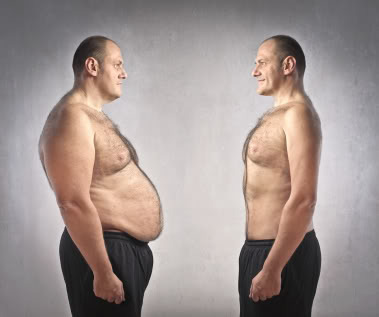 When describing someone that has successfully made the transition to the Primal way of eating I often refer to them as “fat-adapted” or as “fat-burning beasts”. But what exactly does it mean to be “fat-adapted”? How can you tell if you’re fat-adapted or still a “sugar-burner”? I get these and related questions fairly often, so I thought I’d take the time today to attempt to provide some definitions and bring some clarification to all of this. I’ll try to keep today’s post short and sweet, and not too complicated. Hopefully, med students and well-meaning but inquisitive lay family members alike will be able to take something from it.
When describing someone that has successfully made the transition to the Primal way of eating I often refer to them as “fat-adapted” or as “fat-burning beasts”. But what exactly does it mean to be “fat-adapted”? How can you tell if you’re fat-adapted or still a “sugar-burner”? I get these and related questions fairly often, so I thought I’d take the time today to attempt to provide some definitions and bring some clarification to all of this. I’ll try to keep today’s post short and sweet, and not too complicated. Hopefully, med students and well-meaning but inquisitive lay family members alike will be able to take something from it.
As I’ve mentioned before, fat-adaptation is the normal, preferred metabolic state of the human animal. It’s nothing special; it’s just how we’re meant to be. That’s actually why we have all this fat on our bodies – turns out it’s a pretty reliable source of energy! To understand what it means to be normal, it’s useful examine what it means to be abnormal. And by that I mean, to understand what being a sugar-dependent person feels like.
A sugar-burner can’t effectively access stored fat for energy. What that means is an inability for skeletal muscle to oxidize fat. Ha, not so bad, right? I mean, you could always just burn glucose for energy. Yeah, as long as you’re walking around with an IV-glucose drip hooked up to your veins. What happens when a sugar-burner goes two, three, four hours without food, or – dare I say it – skips a whole entire meal (without that mythical IV sugar drip)? They get ravenously hungry. Heck, a sugar-burner’s adipose tissue even releases a bunch of fatty acids 4-6 hours after eating and during fasting, because as far as it’s concerned, your muscles should be able to oxidize them (PDF). After all, we evolved to rely on beta oxidation of fat for the bulk of our energy needs. But they can’t, so they don’t, and once the blood sugar is all used up (which happens really quickly), hunger sets in, and the hand reaches for yet another bag of chips.
A sugar-burner can’t even effectively access dietary fat for energy. As a result, more dietary fat is stored than burned. Unfortunately for them, they’re likely to end up gaining lots of body fat. As we know, a low ratio of fat to carbohydrate oxidation is a strong predictor of future weight gain.
A sugar-burner depends on a perpetually-fleeting source of energy. Glucose is nice to burn when you need it, but you can’t really store very much of it on your person (unless you count snacks in pockets, or chipmunkesque cheek-stuffing). Even a 160 pound person who’s visibly lean at 12% body fat still has 19.2 pounds of animal fat on hand for oxidation, while our ability to store glucose as muscle and liver glycogen are limited to about 500 grams (depending on the size of the liver and amount of muscle you’re sporting). You require an exogenous source, and, if you’re unable to effectively beta oxidize fat (as sugar-burners often are), you’d better have some candy on hand.
A sugar-burner will burn through glycogen fairly quickly during exercise. Depending on the nature of the physical activity, glycogen burning could be perfectly desirable and expected, but it’s precious, valuable stuff. If you’re able to power your efforts with fat for as long as possible, that gives you more glycogen – more rocket fuel for later, intenser efforts (like climbing a hill or grabbing that fourth quarter offensive rebound or running from a predator). Sugar-burners waste their glycogen on efforts that fat should be able to power.
Being fat-adapted, then, looks and feels a little bit like the opposite of all that:
A fat-burning beast can effectively burn stored fat for energy throughout the day. If you can handle missing meals and are able to go hours without getting ravenous and cranky (or craving carbs), you’re likely fat-adapted.
A fat-burning beast is able to effectively oxidize dietary fat for energy. If you’re adapted, your post-prandial fat oxidation will be increased, and less dietary fat will be stored in adipose tissue.
A fat-burning beast has plenty of accessible energy on hand, even if he or she is lean. If you’re adapted, the genes associated with lipid metabolism will be upregulated in your skeletal muscles. You will essentially reprogram your body.
A fat-burning beast can rely more on fat for energy during exercise, sparing glycogen for when he or she really needs it. As I’ve discussed before, being able to mobilize and oxidize stored fat during exercise can reduce an athlete’s reliance on glycogen. This is the classic “train low, race high” phenomenon, and it can improve performance, save the glycogen for the truly intense segments of a session, and burn more body fat. If you can handle exercising without having to carb-load, you’re probably fat-adapted. If you can workout effectively in a fasted state, you’re definitely fat-adapted.
Furthermore, a fat-burning beast will be able to burn glucose when necessary and/or available, whereas the opposite cannot be said for a sugar-burner. Ultimately, fat-adaption means metabolic flexibility. It means that a fat-burning beast will be able to handle some carbs along with some fat. A fat-burning beast will be able to empty glycogen stores through intense exercise, refill those stores, burn whatever dietary fat isn’t stored, and then easily access and oxidize the fat that is stored when it’s needed. It’s not that the fat-burning beast can’t burn glucose – because glucose is toxic in the blood, we’ll always preferentially burn it, store it, or otherwise “handle” it – it’s that he doesn’t depend on it. I’d even suggest that true fat-adaptation will allow someone to eat a higher carb meal or day without derailing the train. Once the fat-burning machinery has been established and programmed, you should be able to effortlessly switch between fuel sources as needed.
There’s really no “fat-adaptation home test kit.” I suppose you could test your respiratory quotient, which is the ratio of carbon dioxide you produce to oxygen you consume. An RQ of 1+ indicates full glucose-burning; an RQ of 0.7 indicates full fat-burning. Somewhere around 0.8 would probably mean you’re fairly well fat-adapted, while something closer to 1 probably means you’re closer to a sugar-burner. The obese have higher RQs. Diabetics have higher RQs. Nighttime eaters have higher RQs (and lower lipid oxidation). What do these groups all have in common? Lower satiety, insistent hunger, impaired beta-oxidation of fat, increased carb cravings and intake – all hallmarks of the sugar-burner.
It’d be great if you could monitor the efficiency of your mitochondria, including the waste products produced by their ATP manufacturing, perhaps with a really, really powerful microscope, but you’d have to know what you were looking for. And besides, although I like to think our “cellular power plants” resemble the power plant from the Simpsons, I’m pretty sure I’d be disappointed by reality.
No, there’s no test to take, no simple thing to measure, no one number to track, no lab to order from your doctor. To find out if you’re fat-adapted, the most effective way is to ask yourself a few basic questions:
Can you go three hours without eating? Is skipping a meal an exercise in futility and misery?
Do you enjoy steady, even energy throughout the day? Are midday naps pleasurable indulgences, rather than necessary staples?
Can you exercise without carb-loading?
Have the headaches and brain fuzziness passed?
Yes? Then you’re probably fat-adapted. Welcome to normal human metabolism!
A quick note about ketosis:
Fat-adaption does not necessarily mean ketosis. Ketosis is ketosis. Fat-adaption describes the ability to burn both fat directly via beta-oxidation and glucose via glycolysis, while ketosis describes the use of fat-derived ketone bodies by tissues (like parts of the brain) that normally use glucose. A ketogenic diet “tells” your body that no or very little glucose is available in the environment. The result? “Impaired” glucose tolerance and “physiological” insulin resistance, which sound like negatives but are actually necessary to spare what little glucose exists for use in the brain. On the other hand, a well-constructed, lower-carb (but not full-blown ketogenic) Primal way of eating that leads to weight loss generally improves insulin sensitivity.
That’s it for today, folks. Send along any questions or comments that you have. I’d love to hear from you guys.
Grab The Primal Blueprint Cookbook Today and Receive Free S&H and a Free Primal Blueprint Poster

July 3, 2012
Top 10 Reasons to Order The Primal Blueprint 90-Day Journal
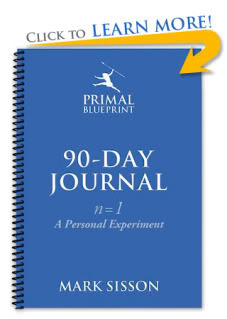 Last week, I unveiled The Primal Blueprint 90-Day Journal, complete with exclusive freebies, enticements, and coupons. Many thanks to each person that has already ordered a copy. I hope and anticipate this book will help you discover new insights into how your body responds to certain foods, workouts and other lifestyle behaviors, and that through self-experimentation you will be able to markedly improve your health. I can hardly wait to hear reports back from those that use the 90-Day Journal. I’ll be publishing them here on MDA, so check back in months to come as results begin trickling in.
Last week, I unveiled The Primal Blueprint 90-Day Journal, complete with exclusive freebies, enticements, and coupons. Many thanks to each person that has already ordered a copy. I hope and anticipate this book will help you discover new insights into how your body responds to certain foods, workouts and other lifestyle behaviors, and that through self-experimentation you will be able to markedly improve your health. I can hardly wait to hear reports back from those that use the 90-Day Journal. I’ll be publishing them here on MDA, so check back in months to come as results begin trickling in.
If you missed last week’s announcement or have been on the fence about picking up a copy, here are the top 10 reasons to grab one in the next 24 hours before the special offer ends.
1. It will give you the kickstart you probably need.
If you are new to Primal, ready to discover what makes you tick and learn what works best for YOU, but don’t know where to begin, this is the book for you. This book tells you exactly how to conduct an “experiment of one” with easy-to-follow instructions and guidance at each step along the way. The Primal Blueprint 90-Day Journal will give you the gentle push you need to kickstart your Primal life.
2. It will help you break through plateaus and find solutions to your health-related problems.
If you are already Primal and seeing great results but there’s that one niggling thing that you haven’t figured out how to fix, this is the book for you, too. Has your weight loss stalled despite your best efforts? Are you all around healthy, but have a blood test result that has you scratching your head? Or are you getting great sleep, but find your energy levels waning in the afternoon? You may only ever be able to identify what needs changing through a systematic process, and this book provides that process.
3. If you’ve enjoyed the recent articles on self-experimentation, you’ll love this book.
As detailed in my posts over the last few months, self-experimentation is an incredibly powerful way to determine what makes each of us unique. But, we’re not all familiar with the scientific method. Some of us need help with making our self-experimentation a little more rigorous and formal. If that sounds like you, the program found in this book is just what you need.
4. Because you want to support MDA!
If you’ve personally received any value from Mark’s Daily Apple and the Primal Blueprint, I hope you will consider picking up a copy today so MDA can continue to thrive and reach more people just like you.
5. Be the first on the block to receive it.
The Primal Blueprint 90-Day Journal will not be available in stores or online retailers (including Amazon.com) until mid-August. You can only get it from PrimalBlueprint.com. So grab your copy today to avoid the wait, and to get the official early adopter badge. (Disclaimer: The early adopter badge doesn’t really exist. Reference to the early adopter badge was only inserted for the purpose of eliciting a few chuckles. Please don’t email me about not receiving an early adopter badge with your journal.)
6. Get a FREE Primal Blueprint wristband.
PBers have been looking for a simple, inexpensive, unobtrusive way to surreptitiously identify other PBers in the wild for years now. But, since facial tattoos were too extreme, spears are illegal in most municipalities, Primal hand signals kept getting mistaken for gang signs, and Vibrams indicate vegan as often as Primal, they never quite settled on the perfect method. Until today. The PB Wristband will allow you to spot fellow PBers and share knowing nods without anyone being the wiser. Order the book today (or tomorrow before midnight) and you’ll get one for free. (Learn how to get this freebie in the original book release post.)
7. Get FREE reader-created eBooks.
When you order one or two books, you get Experiment of One, an eBook compendium of 100 personal experiments created by readers. This is the perfect accompaniment to the journal, especially if you’re not quite sure what you want to test, because you’ll have 100 examples of workable, testable experiments of one. When you order three or more books, you’ll also receive Primal Living in the Real World: Part 2, an eBook chock full of tips, hints, and guides written by PBers on how to make Primal living work in everyday life. (Learn how to get all the freebies in the original book release post.)
8. Get a FREE signed copy of The Primal Blueprint hardcover edition.
MDA receives a lot of new readers every month, and not all of them have caught up with the book that started it all. If you’re one of them, or maybe you just want to pick up the book for your collection, or give it as a gift to someone who really needs it, ordering the 90-Day Journal today will get you a brand spanking new copy of the original PB hardcover. (Learn how to get all the freebies in the original book release post.)
9. Get a $10 or $20 gift certificate toward your future purchase at PrimalBlueprint.com.
Curious about Primal Fuel? Eying one of the T-shirts? Considering Damage Control Master Formula? Wait no more. When you order the book, you’ll get $10 (one or two books) or $20 (three or more) toward a purchase on PB.com. That’s a hefty discount, wouldn’t you say? (Learn how to get all the freebies in the original book release post.)
10. The special offer ends tomorrow!
The special offer ends on Wednesday, July 4, midnight PDT. There’s no better time than now, this is your last chance, you won’t ever get another offer as good as this one, act fast, etc, etc. Marketing hype? Maybe sometimes, in some places, but today, here on MDA? It’s the honest truth. This is a pretty awesome offer; I don’t think anyone can really deny that. If you want to take advantage of it, go ahead and place your order. I’ll even give you a 100% money back guarantee if you don’t like the book, so there’s no way to really lose here (but I’m pretty sure you’ll dig it).
Thanks again, everyone, and Grok on!
Get Your Copy of The Primal Blueprint 90-Day Journal Today – Order by July 4 to Receive Free Gifts

July 2, 2012
Dear Mark: How Much Glucose Does Your Brain Really Need?
 We now know that the oft-repeated “your brain only runs on glucose!” is wrong. I’ve mentioned it before, and anyone who’s taken the time to get fat-adapted on a low-carb Primal eating plan intuitively knows that your brain doesn’t need piles of glucose to work, because, well, they’re using their brain to read this sentence. Obviously, you eventually adapt and find you have sufficient (if not much improved) cognition without all those carbs. That said, some glucose is required, and that’s where people get tripped up. ”Glucose is required” sounds an awful lot like “your brain only uses glucose” which usually leads to “you need lots of carbs to provide that glucose.” And that’s the question today’s edition of “Dear Mark” finds itself attempting to answer: how much glucose is required?
We now know that the oft-repeated “your brain only runs on glucose!” is wrong. I’ve mentioned it before, and anyone who’s taken the time to get fat-adapted on a low-carb Primal eating plan intuitively knows that your brain doesn’t need piles of glucose to work, because, well, they’re using their brain to read this sentence. Obviously, you eventually adapt and find you have sufficient (if not much improved) cognition without all those carbs. That said, some glucose is required, and that’s where people get tripped up. ”Glucose is required” sounds an awful lot like “your brain only uses glucose” which usually leads to “you need lots of carbs to provide that glucose.” And that’s the question today’s edition of “Dear Mark” finds itself attempting to answer: how much glucose is required?
Let’s get to it.
Hi Mark,
I have a little problem. Even though I’m able to function at work, maintain conversations, and go about my daily life without having segments of my brain suddenly stop working while eating Primal, my friends are worried about my brain. All they know is that the brain needs glucose. What can I tell them? How much glucose does my brain actually require to keep working?
Thanks,
Frank
I wouldn’t be too hard on your friends. They mean well and it’s a common misconception. Instead of chiding them, rubbing their faces in the knowledge that you can function quite adequately on a high-fat diet, educate them.
How much glucose the brain requires depends on the context. There’s not one single answer.
If you’re on a very high fat, very low carb diet – like a traditional Inuit diet – your brain will eventually be able to use fat-derived ketones for about 50-75% of its energy requirements. Most ketones are produced in the liver, but astrocytes in the brain also generate ketones themselves for use by neurons. You think we’d have that kind of set up in our brains if ketones weren’t useful to have around? If all we could do was burn glucose up there, what would be the point of even having localized ketone factories? Anyway, since the brain can use about 120 grams of glucose a day (PDF), that means you’d still need at least 30 grams of glucose while running on max ketones.
If you’re merely on a lower carb diet – staying under 150 grams per day or so – or eating medium chain triglycerides (coconut oil, MCT oil) to directly generate ketones, you’ll have access to ketones without being in full-blown ketosis, and your brain will be accessing some of them for energy. Take the story of Dr. Mary Newport, who lessened her husband’s Alzheimer’s symptoms simply by adding a couple tablespoons of coconut oil to his regular diet. The MCTs in the coconut oil were converted to ketones, which his brain began using. You’ll probably need more than 30 grams of glucose, but you won’t need the full 120 grams on a lower carb Primal way of eating (especially if you eat some coconut).
If you’re involved in strenuous exercise, your brain will be running primarily on lactate. Yep, lactate – that unwanted metabolic byproduct of muscle metabolism. During exercise, when the muscles are using up most of the available glucose to lift things and move a bunch of intelligent primate flesh through three dimensional space, and where inadequate oxygen (hence breathing hard) leads to incomplete glucose and pyruvate breakdown and increased lactate levels, the brain will draw upon lactate as a direct energy source. Not only that, but lactate appeared to make the brain run more efficiently, more snappily, and when both are available, the brain prefers lactate over glucose. Other research has found that the brain also prefers lactate in the hours and days immediately following a traumatic brain injury. I’m not sure how much glucose the brain requires when it’s accessing lactate, but it’s definitely fewer than 120 grams.
Of course, even when you need some glucose, that glucose needn’t necessarily come from dietary carbohydrate. It can famously come from gluconeogenesis, the process by which the liver converts amino acids into glucose. It can also come from glycerol, a byproduct of fat metabolism. In deep fasting situations, glycerol can contribute up to 21.6% of glucose production, with the rest presumably coming from gluconeogenesis. The glycerol can come from both dietary fat and adipose tissue (the authors of that glycerol fasting study even suggest that fasting burns body fat in order to provide glycerol for glucose production), while the amino acids can come from dietary protein (if you’re eating) or muscle (if you’re starving).
Overall, recent research into the metabolic demands of brain slices (“living” pieces of brains isolated and used for research) shows that incorporating other energy substrates – ketones, lactate, or even pyruvate – into the glucose solution improves oxidative metabolism and neuronal efficiency. Before you say “but this was in vitro, my brain’s not sliced up and submerged in a weird syrupy solution,” know that the whole point of the study was to better replicate the conditions of the kind of real, actual, living, thinking brains we find in human heads. The authors note that the glucose-only solution normally used to fuel brain slices in other studies is limited, because “in the intact brain, complex machinery exists that coordinates energy substrates delivery and adjusts energy substrate pool composition to the needs of neuronal energy metabolism.” In other words, glucose solution is an easy, dependable way to fuel brain slices, but it’s an incomplete representation of how brains work in heads. The authors conclude that “in slices as well as in vivo, the ability of glucose to maintain energy metabolism is limited and neuronal energy supply should be supported by other oxidative substrates.”
So, a healthy, efficient brain is one that draws on several different fuels. A healthy, efficient brain is one that uses ketones (and perhaps lactate and other fuels) to spare some glucose. A complete reliance on glucose indicates an underachieving brain, a brain that could do so much better, a brain that could really use a coconut milk curry and some intense exercise every now and again. As far as we can tell, then, the absolute physiological minimum is 30 grams of glucose. I wish I could provide hard numbers for some of the other contexts beyond near carnivory (like basic 150 grams carbs Primal eating with coconut or maybe figuring out how to rely on lactate fueling), but the numbers don’t really matter in practice. What matters is that our brains don’t need the full 120 grams of glucose, especially if we’re following a Primal Blueprint eating plan.
I hope that helps.
Questions? Comments? Concerns? Leave them here. Thanks for reading!
Get Your Copy of The Primal Blueprint 90-Day Journal Today – Order by July 4 to Receive Free Gifts

July 1, 2012
Weekend Link Love
 Researchers recently compared the total energy expenditure of patients on four-week isocaloric low-fat, low-glycemic, and low-carb diets. Although activity levels and caloric intake remained the same across all groups, the low-carb group burned 300 more calories per day than the low-fat group.
Researchers recently compared the total energy expenditure of patients on four-week isocaloric low-fat, low-glycemic, and low-carb diets. Although activity levels and caloric intake remained the same across all groups, the low-carb group burned 300 more calories per day than the low-fat group.
Kinda like how bacteria is beginning to outpace our best antibiotics, pests are evolving and adapting faster than ever to get around genetically-modified crops that contain the toxins that are supposed to take care of them.
A pal of mine, Grant Petersen of Rivendell Reader (I did an interview with them a while back), recently came out with a great little book called Just Ride about how you should ditch all the fancy cycling gear and just ride your bike like you did as a kid.
Contrary to previous reports, antioxidant supplementation does not hamper the exercise-induced adaptations in skeletal muscle and mitochondria despite reducing oxidative stress, a 2011 study shows.
Beginning today, TGIPaleo is running a weeklong “Offal Week” series of six or seven easy, delicious recipes that incorporate animal organs and odd bits, the parts we know we should be eating but often don’t. If you’ve ever wanted to get into offal, check out Camilla’s blog.
What if you could get an elegant, functional, stylish, dependable standup desk without dropping five or six hundred bucks? Fund this Kickstarter and make such a product reality (oh, and save about a million lower backs in the process).
The aging male often faces lower testosterone levels, a prospect most assume is inevitable, but research is showing this isn’t actually the case.
Recipe Corner
Grill-less readers, rejoice: here’s a superb recipe for oven-baked ribs.
Marinated mussels are a great way to slip some shellfish into your life.
Time Capsule
One year ago (July 1 – July 7)
Dear Mark: Late Night Work Shifts – What to do when you have to work the night shift.
How Important is Food Variety? – Do humans require an impossibly varied diet to attain optimal health, or does a fairly monotonous diet work just fine? Is variety inherently beneficial?
Comment of the Week
Mark, you are probably not the first to write the words “mescal” and “double blind” in the same sentence. I’m sure Hunter Thompson beat you to it.
- Rand Hagenstein, I thought I’d finally pulled a fast one on old Hunter S., but I guess not.
Get Your Copy of The Primal Blueprint 90-Day Journal Today – Order by July 4 to Receive Free Gifts

June 30, 2012
Primal Purple Potato Salad
 There’s no argument that sweet potatoes, both the regular varieties and the purple Okinawan potato, are delicious served baked and topped with butter. But this isn’t the only preparation method that brings out the best in sweet potatoes. Boiled and cooled and then tossed with homemade mayo, they make a mean potato salad with the perfect balance of sweet, tangy and, if you like, spicy flavor.
There’s no argument that sweet potatoes, both the regular varieties and the purple Okinawan potato, are delicious served baked and topped with butter. But this isn’t the only preparation method that brings out the best in sweet potatoes. Boiled and cooled and then tossed with homemade mayo, they make a mean potato salad with the perfect balance of sweet, tangy and, if you like, spicy flavor.
A light coating of homemade mayo and a small bit of chopped pickle, jalapeno and/or chives is all you need to make this potato salad come together. If you throw too many ingredients into the bowl, you risk overwhelming your taste buds. Remember, sweet potatoes have a lot more flavor than regular old bland, starchy tubers do. If you’re heading out to a BBQ on a hot summer day and don’t want to risk using mayo with raw egg, then simply toss the potato salad with olive oil, vinegar and sea salt. It’s just as delicious.
Because the flavor of sweet potatoes is more robust than regular potatoes and the texture is richer and creamier, a small helping is surprisingly filling and satisfying. The vibrant color, whether it’s the deep purple of Okinawan potatoes or the vibrant orange of most sweet potatoes, also sets this potato salad apart from less exciting bowls of traditional potato salad. Set your purple potato salad out on the pot-luck table and watch it fly. For the ultimate pairing, serve sweet potato salad alongside a salty, savory piece of meat like a grilled steak or pork chop.
Servings: approximately 6
Ingredients:

4 large Okinawan purple potatoes* or regular sweet potatoes
1/4 cup homemade mayonnaise (see below)
One or more of the following:
2 pickles, finely chopped
1 jalapeno pepper, finely chopped
1 tablespoon finely chopped chives
*Okinawan potatoes are often only found at Asian markets.
Homemade Mayonnaise
1 egg yolk, at room temperature
2 teaspoons white wine vinegar
1 teaspoon Dijon mustard
1/4 teaspoon kosher salt
1 teaspoon cold water
3/4 cup olive oil
Instructions:
Peel the potatoes. Cut the potatoes into small chunks that are the same size. Because the flavor is quite sweet and the texture is rich, smaller chunks tend to taste better in potato salad.
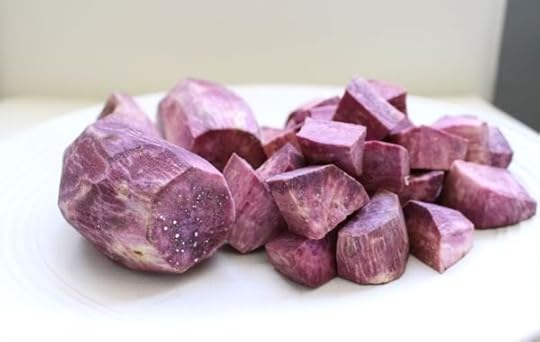
Bring a pot of lightly salted water to a boil, then add the potatoes. Boil until a fork easily pierces the potatoes. The amount of time will vary depending on the size of the potato chunks, but will probably be somewhere between 10-25 minutes.
Drain the water and let the potatoes cool completely.
To make the mayonnaise, whisk together the egg yolk, vinegar, mustard, salt and water by hand until frothy, about 1 minute.

Continue whisking while drizzling the oil in very, very slowly. Once the mayonnaise starts to thicken, you can drizzle the rest of the oil in a bit faster, whisking the whole time. The mayonnaise is done when all the oil has been mixed in and the consistency is fairly thick.

Gently mix 1/4 cup of the mayo with the potatoes. You can use more if you like, but start with this amount and then add more to your taste. Store the remaining mayo in the refrigerator for up to 3 days.
Add salt and pepper to the potato salad to taste. Then, mix in other flavors as desired, starting with 2 finely chopped pickles, 1 finely chopped jalapeno and/or 1 tablespoon of chopped chives.
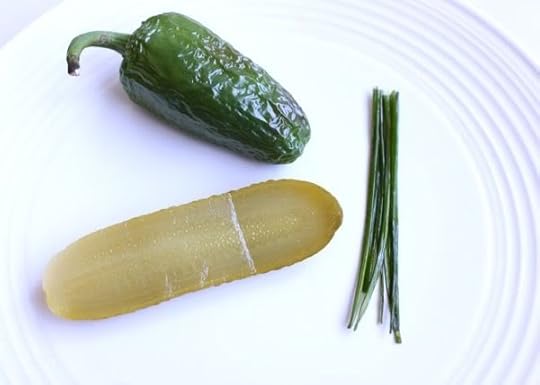
Other possible additions to this potato salad included crumbled bacon, chopped red onion, and hardboiled egg.

Get Your Copy of The Primal Blueprint 90-Day Journal Today – Order by July 4 to Receive Free Gifts

June 29, 2012
384 Days of Primal: Focusing on the Process to See Results
It’s Friday, everyone! And that means another Primal Blueprint Real Life Story from a Mark’s Daily Apple reader. If you have your own success story and would like to share it with me and the Mark’s Daily Apple community please contact me here. I’ll continue to publish these each Friday as long as they keep coming in. Thank you for reading!
 Hi Mark,
Hi Mark,
I’ve been Primal now for over a year. I came upon The Primal Blueprint when searching for resources on paleo dieting. Little did I know that I would find a whole lifestyle that would gel so well with my understanding of the human body.
My initial reasons for going Primal were that I was starting a family. I was studying Medical Nanotechnology at University and was working as an orderly at the same hospital my wife had been working at for 15 years. We were recently married and expecting our first child. Of course, my first child arriving during my mid 30′s made me sit up and think about my health. My initial thoughts had been, “I’ve never smoked, drank or done drugs, so I’m very healthy. I’ll last past 100 easy”. However, what I was seeing every day disturbed me.
As an orderly, the only thing you can offer patients is some comfort through a basic chat. What had disturbed me was the fact that I was talking to a great many people who had renal problems, cancer, etc., and swore blind they’d been following health guidelines as given to them by our government (Australian) and their doctors. At first I thought that they were obviously lying or delusional. However, when it occurred time after time I began questioning. I also began listening to my body and understanding that even though I had a job where I was walking 20,000 steps a day pushing beds and wheelchairs, I didn’t feel fit. My body ached, I injured easily and got easily out of breath. This was strange to me considering that I was following what would be considered a very healthy lifestyle.
So my search began in February 2011. By March 2011 I had read your book, joined your website and was living Primal. The transition for me was no issue. I had been trying to NOT live this way my whole life, so letting go of the reigns was incredibly easy for me. I had no low carb flu even though I was a carb machine prior to PB. I’ve transitioned back into IT (my previous career) as I needed a better income for when bubs came along. So every lunch I walk 4 km to get in my slow movement. I’m known in the office as the guy with the funny looking shoes (VFF’s) who’ll walk in any weather.
I brought a home gym. A Force USA Power Rack that I’m absolutely, insanely happy with. I stick to 3 workouts a week. It’s hard. I want to lift every day, but I force myself to do just the 3 sessions. Sprinting is proving difficult to fit in with bubs here now and another on the way. But I’ll slowly introduce it in.
[image error]
I feel insanely fantastic. It’s sickening to others! I eat my fat-heavy Primal lunches at work and everyone shakes their head at how I got so lean eating that type of food. People always ask me how I did it, then their eye’s glaze over when I tell them. I don’t mind. More meat for me!
Previously I had been told that I could never jog again due to shin splints. Well, I went for a jog a few weeks ago. 2.7 km in my KSO’s. It was the first time I had jogged for any length of time in over a decade. I couldn’t believe the result. The whole jog felt super easy, my breathing was the easiest it has ever been and that’s including when I used to play rugby. The results were amazing and my shins didn’t even get a twinge. I’m not interested in making jogging a part of my normal routine, but it’s nice to know the capability is there when I need it.
Probably the biggest benefit though is that I always have energy for my family. I get up early, get bubs breakfast ready, do a full day of work with my walk in the middle. Come home, clean and sometimes cook. Feed bubs, play with her and bath her, then put her to bed. Then Mon-Wed-Fri I’m out in the shed lifting heavy weights. The amount of work I get through now makes me feel so bad for all the lost years when I had low energy and motivation. Our second pregnancy is taking it out of my wife, the exhaustion has really knocked her about. She’s been on bed rest in hospital for 6 weeks and it looks like she’ll be in there for 6 weeks more at least. Having enough energy to step up and take care of my family the way I have wouldn’t have been possible before Primal.
Although my goal was health, I was keen in watching my weight and waist size. I got so skinny at one point that my wife’s family held a mini-intervention for me during my father-in-law’s birthday party. I proceeded to tell them that I was eating plenty of food. Then I grabbed a little bit of fruit salad, and a massive stack of freshly whipped cream and said, “Try and keep up now!”
My biggest piece of advice to others would be to work the process exactly as PB sets it out. Forget the results for a year. I’ve charted my entire year on PB in an Excel spreadsheet and have some charts to share. I thought these would help people more than a photo of me. You can see from the charts that weight loss was anything but linear and consistent. Remember, this whole time I just worked the process. No real tweaking. I see a lot of forum posts that are along the lines of “It’s been 2 weeks and I’ve hit a plateau”. No, you haven’t. See my charts.
Pure Weight Loss
You can see from this chart that the weight loss was anything but linear and consistent. I tried to measure my weight as often as I could under the exact same conditions everyday. In total I lost about 30 lbs, but then you’ll notice the number go back up around the 273rd day. This was just after I got my Force USA Power Rack.
[image error]
Body Fat %
I measured my BF with Tanita Body Fat Scales (impedance). I measured as often as possible under the same conditions (when I arrived home from work). You can see my body fat drop quite dramatically. It currently sits around 18%. However, I use the standard setting. If I use the Athlete setting, which I probably should now, it says my BF is 10%. But either way, you can see the reduction is quite dramatic.
[image error]
Lean Body Mass
Probably the most telling chart of all. It didn’t change too much at all during the whole process. People kept telling me that eating this way would reduce my muscle mass and I’d rebound later with more fat. I would like to know how long I keep having to prove them wrong before they finally get it.
[image error]
Waist
This is probably the most amazing chart to me. I haven’t had a 34 inch waist since high school!
[image error]
To finish up I’d just like to thank you for putting all of the information together into an easy to follow lifestyle. That’s no easy feat and you and your team have nailed it. It’s made a massive difference in my life and I thank you for it.
Regards,
Shane Roelofs
Run Your Own “Experiment of One” with The Primal Blueprint 90-Day Journal – Order by July 4 to Receive Free Gifts

June 28, 2012
Is It Primal? – Ezekiel Bread, V8, Edamame, and Other Foods Scrutinized
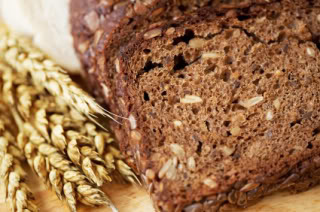 In this “Is It Primal?” series of posts I’ve already scrutinized sprouts, cashews, sunflower butter, chocolate milk and a couple dozen other foods for their suitability in a healthy human diet. Today, I’m covering Ezekiel bread, the sprouted grain amalgamation favored by conventional health nuts; V8, the tomato juice with a little vegetable juice mixed in; edamame, the little kid of the soybean family; mezcal, tequila’s mysterious older brother; and tigernuts, which aren’t what you probably think they are.
In this “Is It Primal?” series of posts I’ve already scrutinized sprouts, cashews, sunflower butter, chocolate milk and a couple dozen other foods for their suitability in a healthy human diet. Today, I’m covering Ezekiel bread, the sprouted grain amalgamation favored by conventional health nuts; V8, the tomato juice with a little vegetable juice mixed in; edamame, the little kid of the soybean family; mezcal, tequila’s mysterious older brother; and tigernuts, which aren’t what you probably think they are.
Ready to go? Let’s do it:
Ezekiel Bread
Ezekiel bread is the stuff that you’d be forced to eat peanut butter and jelly on whenever you went over to your friend-with-the-hippie-parents’ house. The bread would be made from sprouted grains, the peanut butter would be sprouted, and even the strawberry seeds in the strawberry jam would be sprouted. Back then, you just wanted some Wonderbread and Jiffy, but now? Now that you’re health conscious, grain wary, and can rattle off a laundry list of anti-nutrients at a moment’s notice, you see that telltale orange package in the bread section of the Whole Foods and wonder if maybe it’s a decent choice for those times you want to splurge with some buttered bread. So, is it?
Kinda. One study found that eating sprouted grain breads (not Ezekiel, but similar to it) reduced the blood sugar response and increases the glucagon response when compared to eating unsprouted breads, 11-grain, 12-grain, white, or sourdough. That’s pretty good… for a bread. But it’s still bread. I’d like to see it matched up against a lack of bread.
Plus, sprouting might take care of some or most of the phytic acid, but it doesn’t break down the gluten. And with the first ingredient being whole wheat, and other major ingredients including barley and spelt, there’s going to be a significant amount of gluten remaining in the finished product. Some might be degraded, but not all of it. I’d suspect that gluten sensitive people will react “better” to Ezekiel bread, not “well.” Not enough to justify eating it, in my opinion. Celiacs, of course, should avoid it altogether.
Verdict: Not Primal, but possibly better than white bread (and whole grain bread, for that matter).
V8
All your vegetable needs in a can – what’s not to love?
First, the imbalanced sodium/potassium ratio. I have nothing against salt, but it’s fairly well-accepted that an imbalance between sodium and potassium intake is one of the factors involved in developing hypertension. Since one of the best reasons to eat vegetables is to get enough potassium to balance out the sodium you get elsewhere, drinking V8 for the potassium is kinda like eating salmon cooked in soybean oil for the omega-3s. Sure, you’ll technically get some DHA and EPA, but you’ll also get an equal amount of linoleic acid.
Second, seeing as how V8 100% vegetable juice is actually 87% tomato juice (from concentrate), it’s more accurate to say V8 provides all your tomato juice needs in a can. Which is totally fine, but it’s not an effective replacement for your celery, spinach, beet, carrot, lettuce, parsley, or watercress needs. I’m actually a fan of tomato juice, even the pasteurized, reconstituted type. Rather than render it nutritionally void, pasteurization actually increases the lycopene – a potent antioxidant that can help prevent sunburns, among other qualities – content of tomato products (including juice). V8 is great for tomato juice, not “vegetables.”
Third, V8 appears to contain traces of BPA, perhaps because the cans are lined with it (though a type of baby formula had more).
Verdict: Primal – it doesn’t contain added sugar or weird ingredients – but it doesn’t replace actual vegetables.
Edamame
Edamame have several strikes agianst it, right off the bat. It’s soy, which contains potent phytoestrogens, isoflavones that interact with estrogen receptors in the body. It’s a legume. It’s unfermented, unsprouted, and unsoaked. If it’s being served in the United States, it’s likely genetically modified. So, shall I strike it off the list and move on to the next one? No, of course not. That’s not what we do here.
There are actually some “better” things about edamame when you compare them to other forms of unfermented soy:
Edamame are young soy beans, still in the pods. They are not eaten raw, but they don’t require a lot of cooking. A light steam (or run through the microwave, as sushi restaurants do) will sufficiently tenderize the little beans. These aren’t hardy, difficult-to-digest dried beans. They’re more like green peas or green beans, which I previously gave the stamp of approval.
The fatty acids in edamame are mostly monounsaturated (which we like), whereas soybean oil is mostly polyunsaturated linoleic acid (which we usually want to reduce).
Edamame actually have drastically lower levels of phytoestrogens than mature soybeans. One study found that the phytoestrogen content of edamame samples ranged from 0.02% to 0.12%, while mature soybean samples ranged from 0.16% to 0.25%. The gulf widens when you consider that edamame are a snack, eaten sparingly, while mature soybeans are usually converted into tofu, soymilk, and other products that people consume in large amounts.
I couldn’t find solid data on phytic acid levels in edamame, but that could be an indication of researchers’ utter lack of concern for the levels of phytic acid in edamame. I’d imagine that the phytic acid situation is much like the phytic acid situation in other young legumes like green peas and green beans: not very dire.
While I wouldn’t make it a regular part of my diet, edamame appears to be relatively benign as an occasional snack. Just don’t eat bucketfuls, don’t make it baby’s first food, and don’t get into edamame pancakes or some silliness like that.
Verdict: Not Primal, but don’t stress over a couple handfuls at a sushi restaurant.
Mezcal
To my knowledge, there have been no double-blind, placebo-controlled, peer-reviewed clinical trials comparing the health effects of roasted agave liquor, or mezcal, and steamed agave liquor, also known as tequila. Not every dietary item comes with a litany of Pubmed references, unfortunately. Anecdotes, oftentimes powerful ones, are available – especially when it comes to liquor. I have one about mezcal, believe it or not.
I like my wine, but I usually stop after a glass or two or three. I’ve never been a “liquor guy,” though. Scotch, bourbon, rum, vodka? While I can vaguely distinguish between the good stuff and the bad stuff, I’m not a connoisseur. For tequila, though, I make an exception. I love good tequila (and to a lesser extent, good rum). I don’t drink it much, but I really enjoy it when I do. So when I was in Puerto Vallarta some years ago and got to talking to a crusty old ex-pat in a restaurant near the beach, and he mentioned “illegal mezcal,” I was intrigued. According to the ex-pat (and confirmed via Wiki), true mezcal must come from certain states, like Durango, Oaxaca, Guanajuato, Guerrero, San Luis Potosi, and a few others, while any mezcal produced in unsanctioned areas is illegal. Most bootleg mezcal is dreadful, but the mezcal my new companion could get, he assured me, was “real quality, small-batch stuff.”
So we went. It was unlabeled, pulled straight from the oak barrel where it had been aging for almost four years, and dark as amber. Smoky, fruity, and smoother than any tequila I’d ever had, this mezcal was incredible. I wish I could have taken some home.
Is it Primal? I don’t know I have a definite answer, but if you ever get the chance to try an aged mezcal like I did, don’t even consider passing it up. But yes, for my money, apart from mead it is as Primal as liquor can get. It comes from a cactus, rather than a grain. It’s fermented. If you get mezcal anejo (aged), it will have likely picked up some antioxidant activity from the oak barrels, like whiskeys and other oak-aged spirits do. The roasting process might give it a few more advanced glycation end products (AGES), but it’s not like you’re drinking mezcal on a regular basis (right?). And roasting certain foods, like coffee, actually increases antioxidants, so it might be a wash. Skip the clear stuff designed to get you drunk and fast, and go for the dark stuff that’s had care put into it.
Verdict: Primal.
Tigernuts
A single touch of the spacebar makes all the difference in the world, doesn’t it? Imagine if I were to investigate the Primality of tiger nuts. I mean, there are valid arguments on both sides. We eat beef, goat, and lamb testicles on a regular basis (what, you mean I’m the only one?), so why not tiger testes? On the other hand, tigers are carnivores, and we generally don’t eat mammalian carnivores. They’re also endangered, which isn’t a commentary on the health of eating a tiger’s nuts, but still – can’t you find something else to eat? Sheesh.
But this is about tigernuts, not tiger nuts. Tigernuts are a kind of tuber found in a species of sedge native to warm temperate and subtropical regions of the Northern hemisphere. In ancient Egypt, they were pounded and formed into cakes. Today, they’re eaten raw, soaked in water to remove bitter tannins and phytonutrients, dried in the sun to turn into flour, or roasted. Tigernut tubers are fairly high in fat, with most of it being monounsaturated, specifically oleic acid. They contain ample levels of soluble fiber, which can be helpful for feeding gut flora.
Although one study found that tigernuts contain a decent amount of antinutrient factors (some oxalates, saponins, and a tiny amount of phytate), those were mostly mitigated by the roasting process, and a group of lab animals who ate a raw tigernut-rich diet thrived (PDF).
Verdict: Primal.
That’s it for today, folks. As always, keep sending in questionable foods, either through the contact form or in the comment section of this post. Thanks for reading!
Get the Primal Blueprint Fitness eBook, Free Health Tips and Primal Recipes Delivered to Your Inbox

June 27, 2012
Introducing The Primal Blueprint 90-Day Journal
 The Primal Blueprint 90-Day Journal – A Personal Experiment is here, and it goes above and beyond anything you have ever seen in the health and fitness logbook/journal/diary category. Honestly, the project has been in R&D for no less than 30 years, dating back to my days as a competitive endurance athlete when I faithfully logged my workouts in the popular training logs du jour. Even then, I was never terribly impressed with the products on the store shelves. They were (and still are) either too open-ended with no guidance whatsoever, or too limiting, with logbook blanks that didn’t apply to my personal experiences. I thought, perhaps there was a way to marry the best of both worlds: to provide guidance and structure for assorted ability and experience levels, while allowing for sufficient flexibility and free-form expression. This is how the idea for The Primal Blueprint 90-Day Journal was born.
The Primal Blueprint 90-Day Journal – A Personal Experiment is here, and it goes above and beyond anything you have ever seen in the health and fitness logbook/journal/diary category. Honestly, the project has been in R&D for no less than 30 years, dating back to my days as a competitive endurance athlete when I faithfully logged my workouts in the popular training logs du jour. Even then, I was never terribly impressed with the products on the store shelves. They were (and still are) either too open-ended with no guidance whatsoever, or too limiting, with logbook blanks that didn’t apply to my personal experiences. I thought, perhaps there was a way to marry the best of both worlds: to provide guidance and structure for assorted ability and experience levels, while allowing for sufficient flexibility and free-form expression. This is how the idea for The Primal Blueprint 90-Day Journal was born.
N=1 (an experiment of one) is the central theme of this new book. The Primal Blueprint philosophy gives you the structure you need, and the rest is up to you. Plug in lifestyle variables based on your personal preferences and specific goals to determine what makes you tick. The 90-Day Journal allows you to record all types of personal data, such as food and meal choices, workout particulars, sleep and lifestyle patterns, and personal issues that affect your daily rhythm and peak performance.
For example, let’s say you want to observe how average grams of daily carb intake affects your body fat percentage. Or how introducing intense sprint workouts affects your aerobic performance. Or how minimizing artificial light after dark affects your sleep patterns and morning energy levels. You design the experiments, list the variables, conduct detailed progress reports every 30 days, and finish with a masterpiece of scientific data – a personal owner’s manual – when the final page is complete after 90 days.
The n=1 format is an ode to the Mark’s Daily Apple community, and the remarkable back-and-forth dialog each day in the comments following the posts. I’m a busy guy these days, but I really do read all the comments and the valuable insights shared by so many members of our community. I’m firmly committed to the philosophy that the Primal Blueprint is a personal journey, not another regimented program designed for short-term results at the expense of long-term sustainability. I see how you readers have taken a dream and turned it into a movement…so let’s keep the experiment going!
As usual, I want to do something special for devoted Mark’s Daily Apple readers on this book release day. I’m offering some fantastic free gifts for this urgent promotion that expires in just one week on Wednesday, July 4, 12 pm PDT. The 90-Day Journal will only be available from PrimalBlueprint.com for the first couple months of release. See all the details below, but first a little more about the book:
Inside the 282 pages you’ll find:
Detailed, step-by-step instructions on how to conduct personal experiments and use the book to discover how your body works.
Sample experiments for weight loss, improving sleep, moderating systemic inflammation and others to set you off in the right direction.
Spacious, two-page daily journal spreads with assorted customization options for meal and workout particulars, subjective “Success Scores” (for daily energy, motivation, health and goal progress), and data from unique personal experiments that you design and track during your 90-day journey.
Baseline, 30, 60, and 90-day evaluations to help you track your progress and analyze your data.
An extensive discussion on testing various blood markers with accompanying journal entry pages.
A handy Primal resource section covering all the key Primal Blueprint concepts, food and meal suggestions, workout guidelines, macronutrient values for common meals and snacks, and more.
This book represents a thoughtful presentation of everything you need to conduct your own personal experiments, to stay focused, accountable, and motivated to live Primally. And it’s the perfect companion book to The Primal Blueprint and the Primal Blueprint 21-Day Total Body Transformation. So grab your copy today:
What Freebies Do I Get When I Purchase One or More Copies?
Order 1 Copy and You Get:

1. Experiment of One: 100 Personal Experiments Created by Mark’s Daily Apple Readers: Earlier this month, I asked Mark’s Daily Apple readers for their ideas for personal experiments. I received hundreds of responses, and this eBook showcases the best of them. Broken into nine chapters, including chapters on weight loss, sleep, improving digestion, and increasing energy levels to name a few, this eBook stands as a perfect jumping off point for your experiments of one. Uncover how your body works, how it responds to certain foods and different types of exercise, and customize the Primal Blueprint way of life to meet your unique needs. If you’re lacking for experiment ideas, your fellow MDA readers and this eBook have you covered.

2. Primal Blueprint Wristband: You’ve been asking for Primal Blueprint wristbands for years. They’re finally available. This debossed wristband is imprinted with “Primal Blueprint” and the image of Grok. It’s made of durable, waterproof silicone, and is the perfect way to show your support for the Primal way of life. You can be the first to get your hands on one when you buy a copy of the 90-Day Journal.

3. $10 Gift Certificate to PrimalBlueprint.com: Spend it like cash and order whatever you want, perhaps a cookbook to go with the 90-Day Journal? Maybe this is the perfect opportunity to try a Primal Essentials Kit, Primal Fuel or Master Formula on for size! (The coupon code is good for any product at PrimalBlueprint.com and expires on 07/31/12.)
Order 3 (Or More) Copies and You Get:
1. All the aforementioned freebies – the $10 Gift Certificate, the wristband, and the eBook plus…
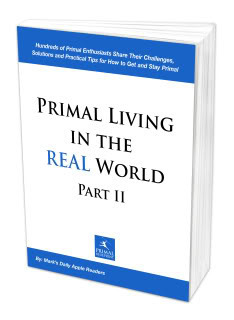
2. Access to the exclusive, password-protected eBook – “Primal Living in the REAL World: Part 2″: In this 134-page eBook, hundreds of Primal enthusiasts share their challenges, solutions and practical tips for how they get – and stay – Primal. It’s like having the advice of 300 coaches. Still new to the Primal Blueprint and just trying to figure out the basics? Part II of this reader-created series is just what you need. Ever wonder how to keep costs down while eating Primal? Or what to feed Primal kids? Or how to go Primal with an unsupportive spouse? Are you struggling with adding more play time into your life, or with finding your 80/20 balance? You’ll find solutions to these and many more questions in this eBook.
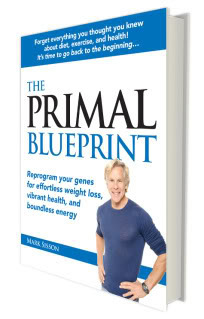
3. A signed copy of the original Primal Blueprint hardcover edition (released in 2009): This is the book that started it all. If you haven’t read it, you have some catching up to do!
Earlier this year The Primal Blueprint was released in paperback format, and there aren’t plans to do another hardcover printing. I still have a handful of hardcovers in stock, but numbers are dwindling quickly so this could be your last chance to grab a copy of the hardcover before new copies are gone forever. If you already own a copy of The Primal Blueprint this is the perfect opportunity to pick up a free copy for a friend or family member. And whether it’s for you or some other lucky recipient, I’ll include my John Hancock in the book.

4. Plus an additional $10 Gift Certificate to PrimalBlueprint.com, bringing the total to $20. This means for a net 3 bucks you can grab a copy of my new book today. (The coupon code is good for any product at PrimalBlueprint.com and expires on 07/31/12.)
How Do I Get These Freebies?
1. Order your book(s) at PrimalBlueprint.com before midnight Wednesday, July 4:
2. Email your receipt to the appropriate email address:
If you purchase 1-2 copies email your receipt to 1book@primalblueprint.com
If you purchase 3 or more copies email your receipt to 3books@primalblueprint.com
3. You will receive your gift certificate code and eBook (PDF) download instructions by reply email. (Please be patient. The Worker Bees will be reviewing receipts and sending you instructions on how to access all of your freebies within 24 hours.)
Thank you for your participation and support! If you have any questions about ordering, or this promotion, please email us for an immediate, timely response, or call 888-774-6259 (or 310-317-4414).
Fine Print:
I’ll honor any 90-Day Journal pre-orders made on Amazon.com before today, June 27. Just follow the instructions above to get your freebies.
Coupon code discounts used on orders containing products that automatically bill and ship every 30 days only apply to the first order, and not subsequent automatic delivery orders.
Primal Blueprint wristbands and the hardcover edition of The Primal Blueprint will ship with your order of the 90-Day Journal. The wristbands will NOT show up in your shopping cart upon checkout, but they will ship with your 90-Day Journal.
There are no shipping and handling charges for domestic orders of the 90-Day Journal. There is a $9.95 handling fee for all international 90-Day Journal orders.
Please allow 7-14 business days to receive your order.
Please show your support for Mark’s Daily Apple and share this post with the world by clicking the Facebook, Twitter, Pinterest and Email buttons below.

Mark Sisson's Blog
- Mark Sisson's profile
- 199 followers


